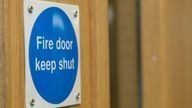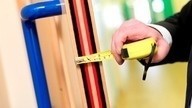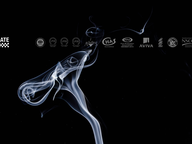Buildings are compartmentalised to delay the spread of fire from one area to another. These compartments are usually linked by fire doors to allow the flow of traffic around the building.
Fire doors have two important functions in a fire; when closed they form a barrier to stop the spread of fire and smoke and when opened they provide a means of escape.
A well-designed timber fire door will delay the spread of fire and smoke without causing too much hindrance to the movement of people and goods.
Every fire door is therefore required to act as a barrier to the passage of smoke and/or fire to varying degrees depending upon its location in a building and the fire hazards associated with that building.
How often should I have my fire door inspection?

Depending on the type of building you are responsible for and who occupies it will influence the frequency of fire door inspections required. Some buildings, such as schools and hospitals, are subject to heavy traffic and the doors have a hard time often being subject to repeated misuse.
BS9999 recommends six-monthly inspections and includes guidance on some of the main inspection criteria, but remember that you are responsible for ensuring adequate inspections and maintenance routine is in place.
Identifying fire doors
Certified fire doors
Manufacturers can certify fire door sets, both for identification purposes and to guarantee their performance in a fire situation. The first step for the manufacturer is to construct a fire door set designed to a specification that, in their opinion, will resist a fire for a specified length of time. This door set will then be tested by an approved fire testing centre and, if it is passed, any door sets constructed to that specification can be considered for certification.
Once the certification is approved, each similarly constructed door set will be identified by a label identifying the manufacturer, the date of manufacture and the designated fire rating of the door type. This identification label is usually affixed to the top edge of the door.
Identification marks can sometimes be removed or painted over during the installation or adjustment of a fire door set but, if the work has been professionally carried out under the auspices of the BWF/FIRAS Accredited Fire Door Installers Scheme, the chance of this happening can be avoided.
The importance of fire doors
Every fire door is therefore required to act as a barrier to the passage of smoke and/or fire to varying degrees depending upon its location in a building and the fire hazards associated with that building.
A fire door required to provide resistance to the passage of a well-developed fire must be fitted with intumescent seals. These seals remain dormant under normal conditions but expand greatly in the heat of a fire to close the gap between the door and its frame. As smoke spread is an even greater threat to life and property than flames, particularly in the early stages of fire, fire doors should also be fitted with a “cold smoke” seal to prevent the ingress of smoke around the door edges. Combined smoke and intumescent seals protect from all aspects of fire in a single unit.
For this reason, fire doors should be inspected at least once a year, but where a door is heavily used, it should be inspected more regularly; dependent on its frequency of use.
What type of fire doors do I have?
However, the generic term “fire door” is frequently used to describe differing types of fire door, each having separate functions. Knowing the function of each is important to ensuring fire doors perform effectively when required. The following should clarify the situation and assist those responsible for the management of fire safety:-
Fire resisting doors – These are used to protect staircases and certain single direction escape routes from smoke and toxic products of combustion for a period of time sufficient to evacuate occupiers from the building. They are also used to contain areas of high fire risk. Such doors are required to be self closing or, in the case of cupboards and stores, may be kept lock shut when not in use.

Smoke stop doors – These are sited in specific locations to restrict the movement of smoke and toxic products of combustion in escape routes, generally corridors. These doors also have the secondary purpose of preventing smoke damage to uninvolved areas of the building as this can sometimes cause more damage than the fire. Smoke stop doors also have a fire resisting role and in all cases should be self closing.
Final exit doors – As the name suggest these give access to open air outside the building where people can move safely to their designated assembly point. Final exits should always open without the use of a key, card or pass code whenever the building is occupied.
There is a legal obligation to maintain the functionality of the above doors, it’s therefore vital they are kept in good order and where fire resisting doors are required to be self closing, are only held open by an approved systems that will automatically release the doors on the operation of the fire alarm.
How to Identify Fire Resisting and Smoke Stop Doors.
These doors will be of substantial construction and should meet the following criteria:
- Be at least 38mm thick
- Have intumescent strips fitted (Heat seals)
- Have smoke seals fitted – If door gives access to a staircase or corridor with travel in one direction only
- Self closing device if door provides general access and is in regular use but may be Locked Shut if not in general use
- Glazing should be 6mm wired or have an approved fire resisting product identification etched into one of the corners of each pane
- Have suitable signage attached to both faces of the door which is likely to be:
- “Fire Door – Keep Shut” if door is generally in use;
- “Fire Door – Keep Locked Closed” on cupboard doors or doors to store not in general use.
- “Automatic Fire Door – Keep Clear” in cases when self closing doors are held open by automatic release devices.
Maintenance
It is important that your fire doors are regularly inspected and maintained to ensure that they perform at their best, on the one and only occasion when they are called upon to do so
Door sets fitted with hold open devices or swing free type closers should be closed daily, particularly overnight when there is likely to be low building occupancy. For busy 24/7 buildings (e.g. hospitals) fire doors should be closed at least weekly. All fire doors should close effectively from any angle of opening, using only the door closer.
There are a number of reasons why doors may fail to close:
- Foreign bodies or other objects may be obstructing the door.
- The smoke seals may be incorrectly fitted or damaged.
- If a latch is fitted, it may be malfunctioning or require lubrication.
- The closing device may need adjustment but this must only be done as a last resort, and very carefully, to ensure that the door can be opened without undue force
So what is covered during our fire door inspection?
During a fire door inspection our technicians inspect each component of the fire door assembly including:
- Door leaf
- Door frame
- Door closer (self-closing devices)
- Hinges
- Intumescent door strip and cold smoke seals
- Glazing (vision panels)
- Locks and levers/handles
- Fire safety signage
- Hold open devices
- Gaps around the doors and threshold gaps
- Panic hardware devices for external final fire exit doors
Upon completion of fire door and final fire exit door inspections, a report is produced detailing the condition of each door and listing the areas of non-compliance, which in turn creates a register for future on-going inspections.
Related pages

Don't be Passe about Passive Fire Protection
It can be all too easy to lose sight of critical fire safety features, either because they’re in plain sight and taken for granted, or because they are hidden away in a building’s fabric.

‘Path to Passive Fire Compliance’ CPD a Huge Success!
Checkmate Fire enjoyed another successful CPD event, hosted by our insurance partners, Aviva, in Bristol this month.

The Silent Killer
Smoke inhalation is the primary cause of death for victims of indoor fires. Smoke inhalation injury refers to injury due to inhalation or exposure to hot gaseous products of combustion.


















